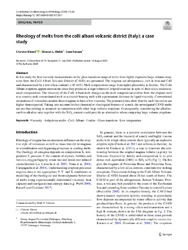Rheology of melts from the colli albani volcanic district (Italy): a case study
DOI: https://doi.org/10.1007/s00410-020-01720-1
Persistent URL: http://resolver.sub.uni-goettingen.de/purl?gldocs-11858/10802
Persistent URL: http://resolver.sub.uni-goettingen.de/purl?gldocs-11858/10802
Kleest, Christin; Webb, Sharon L.; Fanara, Sara, 2020: Rheology of melts from the colli albani volcanic district (Italy): a case study. In: Contributions to Mineralogy and Petrology, Band 175, 9, DOI: 10.1007/s00410-020-01720-1.
 |
Dokument öffnen: |
In this study the first viscosity measurements in the glass transition range of melts from highly explosive large-volume eruptions from the Colli Albani Volcanic District (CAVD) are presented. The magmas are ultrapotassic, rich in iron and CaO and characterised by a low silica content (< 45 wt%). Melt compositions range from tephri-phonolitic to foiditic. The Colli Albani eruptions appear anomalous since they produced a large volume of erupted material in spite of their silica undersaturated compositions. The viscosity of the Colli Albani melt changes as the melt composition evolves from the original melt to a country-rock contaminated melt to a crystal-bearing melt with a permanent decrease in liquid viscosity. Conventional estimations of viscosities assume these magmas to have a low viscosity. The presented data show that the melt viscosities are higher than expected. Taking into account further chemical or rheological features of a melt, the investigated CAVD melts are not that striking as assumed in comparison with other large-volume eruptions. Consequently, considering the alkaline-earth to alkaline ratio together with the SiO2 content could provide an alternative when comparing large volume eruptions.


